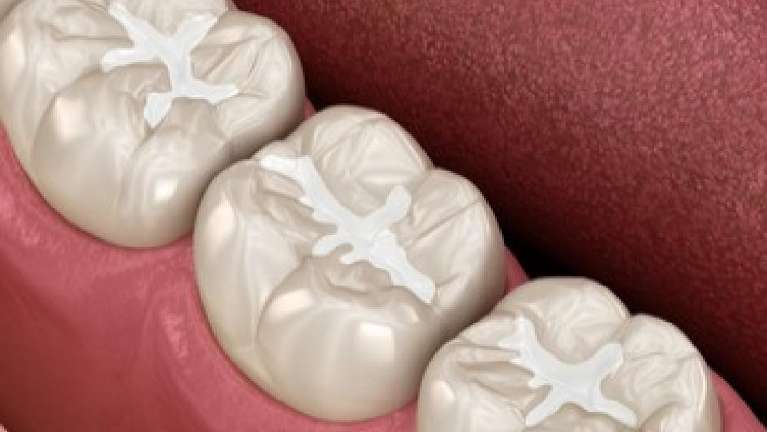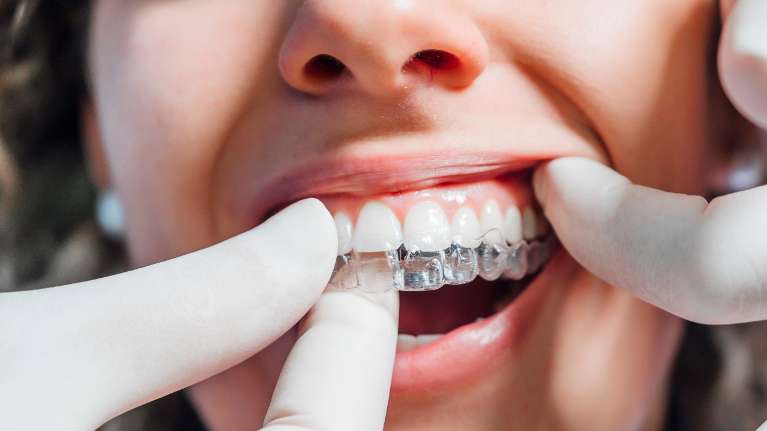
Whilst the normal anatomy of teeth varies person to person, most molars tend to have pits and grooves in them. Some of these may be shallow and unretentive, others may be deep and fissured. The latter composition generally results in food and plaque getting easily stuck inside them. Overtime, when the plaque builds up, it becomes harder to properly clean and maintain the health of your back molars, making them more vulnerable to decaying. This issue of decay can occur as early as when the adult molars first erupt.
What are fissure sealants & how can they help?
Fissure sealants are thin, white/ tooth-coloured coatings placed along the fissures to provide a barrier and “seal” the decay-prone pits and grooves on your molars. The sealant is bonded to each surface of a tooth to prevent food and bacteria from collecting on it. Some sealants may contain fluoride; once placed on a molar, the fluoride is released into the tooth, helping it strengthen and become better resistant to decay.
When may you need fissure sealants?
Sealants are usually recommended when the first and second adult molar teeth erupt, typically around the age of 6 and 11, respectively. It is also recommended for adults with susceptible fissures.
If your teeth have large grooves or pits, your dental practitioner may advise you to have fissure sealants. Note, not all teeth with fissures require sealants, so it’s best to first consult your dental practitioner about whether the sealants are necessary for you.
Fissure sealants may also be recommended when there is superficial decay present in a molar pit or fissure. They are effective in stopping the further progression of superficial decay by feeding on any food or oxygen they contact.
What is the dental fissure sealant procedure?
Fissure sealants are very quick and pain free. It usually takes only a few minutes per tooth and is far less complicated than a tooth filling. Sealants don’t involve drilling and require no anaesthetic.
When going through fissure sealants procedure, your dental practitioner will:
1. Clean the tooth so it’s free of any plaque or food
2. Prepare the tooth surface and isolate the it from saliva so that the sealant can properly bond to the tooth
3. Paint on a liquid, tooth-coloured sealant into the deep grooves and pits of your molars
4. Harden the sealant with a blue light
5. Check the bite and polish if required
What are some of the benefits and potential risks associated with fissure sealants?
Sealants are known to significantly reduce the risk of tooth decay. The firm coating on your tooth will protect your molars against food or plaque getting stuck, which even the bristles of a toothbrush may not be able to reach or remove.
Though complications are rare, it important to be aware that certain patients can be prone to having an allergic reaction to the sealant. If you suspect that you could suffer from such a reaction, consult your dental practitioner before receiving the treatment. On occasion, if the sealant placed on your molar is too thick, it may change your bite. However, know that your dental practitioner will check the bite after the sealant placement and will polish off any excess material to preserve your natural bite.
How long do fissure sealants last?
Fissure sealants usually last for many years but, in some instances, they can fall off. This can be caused by many factors - most probable being that they’ve been worn down over the years - so the best way to preserve them is by making regular visits to the dentist for routine check-ups, condition assessment and cleaning. Also note, sealants may wear down more rapidly if you tend to grind or clench your teeth and eat or snack on a lot of hard foods.
How much does it cost to get fissure sealants?
The price of fissure sealants can vary depending on the health of your molars as well as whether you have health insurance. Typically, however, they cost around $40-$90 per tooth.
What are the alternatives to fissure sealants?
If you’re not looking to receive a fissure sealant treatment but want to seal your grooves or pits, a recommended alternative is getting fluoride varnish. It is applied into the grooves and other high-risk areas by the dental practitioner and remineralises the teeth, making them stronger. Yet the varnish will be removed when brushing or eating occurs, so it is much more temporary solution to fissure sealants.



